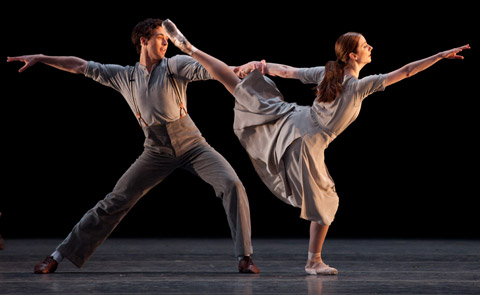
THIRTEEN DIVERSIONS Christopher Wheeldon’s piece, set to music by Benjamin Britten, behaves like a plotless classical ballet that’s been jarred loose from the traditional symmetries and line-ups. |
NEW YORK — American Ballet Theatre devoted only four performances of its two-month spring season at the Metropolitan Opera House to a mixed bill of short ballets. The rest of the schedule was given over to evening-length story ballets of the 19th century and their latter-day offspring.
The old-fashioned standards were built for great solo dancing; without that, they're costly diversions. Even a great company, with the most authoritative dancers, doesn't always deliver great performances. But last week, after two nights of the mixed program, I saw a transcendent Giselle, with Diana Vishneva in the title role, partnered by Marcelo Gomes as Count Albrecht, and Veronika Part as Myrtha, Queen of the Wilis, Gennadi Saveliev as Giselle's village suitor, Hilarion, Susan Jones as her solicitous, clairvoyant mother, Berthe, and a sensitive supporting cast and corps de ballet.
By some miraculous chemistry, the venerable story of betrayal and forgiveness vaporized into a spume of the purest classical dancing. Evenings like this happen a few times in a lifetime, but the story-ballet formula, with its contending characters and interlocking worlds, makes them possible. Vishneva dances only three more times at the Met, but ABT's season runs through July 9, including eight performances of Alexei Ratmansky's The Bright Stream (June 9-15), and we live in hope.
ABT's mixed program, consisting of three new works and a revival, showed how choreographers set out to reformulate and reframe the classical models. Antony Tudor lived most of his creative life as a resident choreographer for ABT, but he returned to his native England and the Royal Ballet in 1967 to make his Orientalist psychodrama Shadowplay. Tudor's output was small and serious; critics have respectfully tended to overlook Shadowplay's shortcomings in favor of its otherworldly aspirations. I've seen it with its original protagonist, Anthony Dowell, and in 1975, when ABT acquired it for Mikhail Baryshnikov. The current revival was intended for Herman Cornejo, but injuries prevented him from performing. I saw casts headed by Craig Salstein and Daniil Simkin.
Set to a lush, post-impressionist score by the French composer Charles Koechlin, Shadowplay is not Tudor's only coming-of-age ballet, but it's his most enigmatic. Here, the central character seeks and attains both sexual and spiritual maturity. Or call it Nirvana. Tudor was a practicing Buddhist, and Shadowplay came to the stage at the height of the hippie era. These might be clues to the mysterious encounters between the Boy With Matted Hair and a forest full of creatures and deities. In Michael Annals's new set, a huge, gnarled tree, whose base serves as a kind of throne, twists upward into the shape of a many-armed Shiva.
The Boy tussles with troupes of monkey-like Arboreals, flittering Aerials, and a Terrestrial, who may be an aspect of Shiva or of the Boy himself. He contests with and eventually chases away the creatures. His battle with the Terrestrial culminates when the Boy repels the sexual advance of this adversary and guide. He's then presented with an alluring female Celestial. After a seduction, which resembles a Cambodian dance duet, the Boy capitulates. Then the choreographer depicts a grand procession with all the forest characters massed together to carry the Celestial like a Hindu goddess. The Boy dives into the mass, submitting to and submerging himself in her physical and spiritual power. He returns to the throne and settles into a yogic pose along with his fellow creatures.